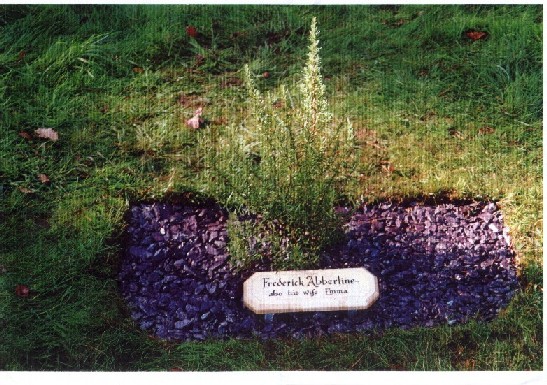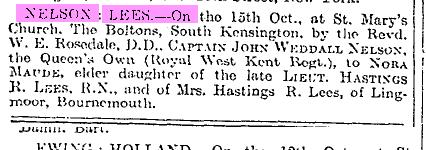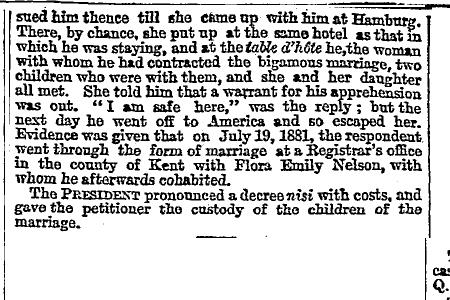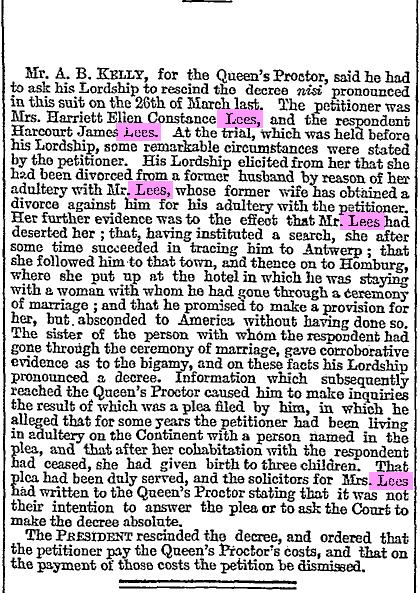
|
 |
 |
 |
 |
 |
| Author |
Message |
    
Robin
Police Constable
Username: Robin
Post Number: 1
Registered: 6-2004
| | Posted on Saturday, June 05, 2004 - 5:43 pm: | 





|
On Saturday, 29th September 2001, Deputy Assistant Commissioner John Grieve of the Metropolitan Police unveiled a Blue Plaque to Frederick Abberline. This plaque is on the front outside wall of 195 Holdenhurst Road, Bournemouth, Dorset., which was Abberline’s home until his death in 1929. This ceremony coincided with the Ripper Conference held in Bournemouth that year.
That Saturday also saw DAC Grieve’s and others (including Conference delegates) attend the planting of a rosemary bush on the then only recently identified and simply marked grave of Frederick and his wife, Emma, at Wimborne Road Cemetery, Bournemouth. Sadly, this rosemary bush did not survive its first winter.
Today, Saturday, 5th June 2004, my wife, Sonia, my friend Ken (a retired Metropolitan Police Officer), and I replaced the failed rosemary bush with one that Sonia has been nurturing for the last two years especially for this event. We tidied the site (a small bed of shale with a wooden marker), and will return periodically to ensure that this time the rosemary bush flourishes.
At the time of the Bournemouth Ripper Conference, there was a talk of a proper headstone being placed on the Abberline’s grave. Nothing has happened since, so I have taken it upon myself (rightly or wrongly) to see if I can stir the people concerned into action. I plan to contact the various parties concerned, shortly.
If you feel that you can help me in this project in any way, please do e-mail me at robin.a.lacey@btinternet.com
Bournemouth Council has a PDF format article on the unveiling of the Blue Plaque at http://www.bournemouth.gov.uk/Library/PDF/Living/Planning/Abberline5.pdf
Regards to all,
Robin
|
    
Jennifer D. Pegg
Inspector
Username: Jdpegg
Post Number: 323
Registered: 2-2003
| | Posted on Sunday, June 06, 2004 - 6:45 am: | 





|
Robin,
Nice to see you back on the boards. I was not aware of the situation re Abberline's grave (I thought it was all sorted out. I remember seeing posts from you on the old boards re this etc). I've e-mailed you.
cheers
(Message edited by jdpegg on June 06, 2004)
Jennifer
|
    
Robin
Police Constable
Username: Robin
Post Number: 2
Registered: 6-2004
| | Posted on Sunday, June 06, 2004 - 6:20 pm: | 





|
Hello Jennifer,
Thanks for the welcome. It's good to be back...
I received your e-mail and will be directly in touch shortly.
I have re-discovered a photograph I have of Abberline's grave as it was at the time of the 2001 Ripper Conference in Bournemouth.
I'll be posting a copy here once I've figured out how to do it.
Regards,
Robin |
    
Jennifer D. Pegg
Inspector
Username: Jdpegg
Post Number: 324
Registered: 2-2003
| | Posted on Monday, June 07, 2004 - 6:01 am: | 





|
Hi Robin,
Hope to be of some help and look forward to your email.
regards
Jennifer
|
    
Robin
Police Constable
Username: Robin
Post Number: 3
Registered: 6-2004
| | Posted on Monday, June 07, 2004 - 5:24 pm: | 





|
Hello everybody,
Today I had a long, interesting and informative conversation with the Bereavement Services, Bournemouth Borough Council. As I understand it, in view of the absence of surviving relatives (as far as is presently known), and if I can gain the support of a recognized and interested body (such as London’s Metropolitan Police), Bournemouth Council would not object to the placing of a memorial stone on Frederick's and Emma's grave.
However, the person I had the conversation with did raise an interesting and potentially morally problematic point. Graves are sometimes unmarked because that is what the deceased and or their family wished. At present, I do not know whether this applies to the Abberlines. However, that his wife, Emma (who passed away about a year after Frederick), did not - as far as I know - mark Frederick’s grave suggests that this might have been the case.
Because of this uncertainty, I would like to suggest that perhaps it would be appropriate only to place a small and discreetly worded engraved stone plaque on the grave. Something that does not overtly draw attention to the grave, but at the same makes it known that Frederick and Emma are not forgotten. Perhaps replacing the grave’s existing but steadily deteriorating wooden plaque with an engraved stone version would be appropriate (please see the photograph below). I would be most interested to know what you, the reader, think.
It would help me if I could get a measure of the man, Frederick George Abberline. To help me with this, I am currently searching for a booklet that a local man wrote and privately published some years ago about Frederick’s time in Bournemouth.
Which brings to mind an issue that Jennifer and I have just e-mailed each other about (Jennifer has kindly given me permission to mention on this Board the contents of her e-mails to me on this subject). The portrayals in television and cinema of Frederick G. Abberline as a drunkard (Michael Caine in Granada TV’s “Jack the Ripper”) or a drug addict (Johnny Depp in “From Hell”). I believe I am right in thinking that in both of these cases; the portrayal was solely in interests of drama and not at all true.
If you, the reader, have any information on Frederick as a person, I would like to hear from you.
I now intend to contact the Metropolitan Police and speak to the persons who I know to be interested in this matter. I’ll keep you posted.
Regards to all,
Robin
 |
    
Jennifer D. Pegg
Inspector
Username: Jdpegg
Post Number: 329
Registered: 2-2003
| | Posted on Tuesday, June 08, 2004 - 6:23 am: | 





|
Hi all
Robin, thanks for posting the picture. I have emailed you (hopefully)
Cheers
Jennifer
|
    
Michael - Bournemouth Conservation Team
Unregistered guest
| | Posted on Monday, September 20, 2004 - 11:04 am: | 





|
Hello Folks,
When the issue of placing some kind of grave marker was last raised, I believe we had made contact with some relatives of Abberline - possibly via his wife - who had given their consent to the grave being marked. But things got that far, and then seemed to flounder on the issue of raising money for the headstone - or whatever was going to be placed.
I understand that Abberline was quite an ordinary sort of chap, neither a drug addict, nor a drunkard, and that the portrayals in the films are entirely ficticious. Personally I found Mr. Depp to be particularly dire, as his research form the role seems to have consisted with studying Dick van Dyke, to perfect his 'Cockerney-Accent'; a little odd for a Dorset born copper.
Abberline turned to a local wine merchant Nelson Edwin Lees to be his executor. I have seen this mentioned in terms of a possible connection to Lees the paranormalist, but don't know if anyone has followed this lead through.
Bournemouth has several other Ripper links, including the Druitts be local residents, and R. L. Stevenson living here whilst writing Jeckyl and Hyde. And of course there are some references to various vets and lodgers suspected of being the Ripper as having mothers living in Bournemouth.
Any other connections that people know of are very welcome.
You might be interested to see an extract from the Bournemouth Visitor's Directory which mentions an intriguing Ripper message, which I have not seen reported elsewhere ‘Five; 15 more, and then I give myself up.’
The Bournemouth Visitors Directory, Wednesday September 12, 1888
Another murder in Whitechapel.
Shocking mutilation of the victim.
At five minutes to six on Saturday morning, a man named John Davis, living at 29 Hanbury street, Spitalfields, discovered that a woman had been murdered in the yard at the rear of that house, and when the police were called in, the circumstances attending her murder made it clear that she was another victim of the miscreant who murdered Mary Ann Nicholls in Buck’s Row, Whitechapel, only a week previous. The same horrible ferocity had been exhibited in the commission of the crime, and the victim was again an ‘unfortunate’ so poor that robbery could scarcely be suggested as a motive for the murder. The house, 29 Hanbury Street (which is not half a mile from buck’s Row) is let out by rooms to several people, all very poor and struggling. The front parlour is in the occupation of a Mrs. Hardiman, who uses it as a shop for the sale of cats’ meat. She and her son also sleep in the room. The back parlour is a sort of sitting room for the landlady and her family, and looks out upon a yard, at the further side of which stands a shed. The passage of the house leads directly to the yard, passing the door of the front parlour, the yard being about four feet below the level of the passage, and reached by two stone steps. The position of the steps creates a recess on their left, the fence between the yard and the next house being about three feet from the steps. In this recess, John Davis, as he crossed the yard at five minutes to six o’clock, saw the body of a woman horribly mutilated, and her throat so terribly gashed that the head was nearly severed from the trunk. Davis seems at once to have run out and called in Police Constable Pinnock, 238 H, who sent information to the station in Commercial Street. Inspector Chandler, on duty, with others, hurried to the place, and before the body was removed from its position, the divisional surgeon, Mr. George Bagster Phillips, of Spital Square, was called to examine it. The fiendish character of the mutilation then became revealed. There was no doubt, he said, that the throat was first cut and the stomach subsequently mutilated. As in the case of Mary Ann Nicholls, in Buck’s Row, the body had been ripped up. The body was moved as soon as possible to the mortuary of the parishes of Whitechapel and Spitalfields, in Old Montague Street and placed in a shell – the same in which a week before the corpse of the previous victim had been placed. The precise description of the body was quickly made out, and before ten o’clock it was identified as that of Annie Chapman, alias ‘Sivvey’ a name by which she had become known through living with a sieve maker. One of the same class as Mary Ann Nicholls, her usual places of abode were also in the common lodging-houses of Spitalfields and Whitechapel. A stout, well-proportioned woman, of about five feet in height, she was described a s’quiet’ and as one who had ‘seen better days’. Detective Inspector Abberline, of Scotland Yard, who had been detailed to make special inquiries as to the murder of Mary Ann Nicholls, at once took up the inquiries with regard to the new crime, the two being obviously the work of the same hands. He held a consultation with Detective Inspector Helsan, J division, in whose district the murder in Buck’s Row, was committed and with Acting Superintendent West in charge of the H division. The result of that consultation was an agreement in the belief that the crimes were the work of one individual only, and that notwithstanding many misleading statements and rumours – the majority of which, in the excitement of the time, had been printed as facts – the murders were committed where the bodies had been found and that no ‘gang’ were the perpetrators. It having been stated that the woman must have been murdered elsewhere and her body deposited in the yard, the house door giving access to the passage and the yard being never locked, the most careful examination was made of the flooring of the passage and the walls, but not a trace of blood found to support such a theory. It is moreover considered impossible that a body could have been carried in without arousing from their sleep, Mrs. Hardiman and her son, past whose bedroom door the murderer had to go. There is no doubt that the deceased was acquainted with the fact that the house door was always open, or ajar, and that she and her murderer stealthily passed in to the yard. Although, as in the case of Mary Ann Nicholls, a very small quantity of blood was found on the ground (which would lead to the supposition that the murder was committed elsewhere) its absence is accounted for by the quantity the clothes would absorb. The throat being so completely severed, it is the opinion of medical experts, would preclude the slightest cry, and the tenants of the house agree that nothing was heard to create alarm. The back room on the first floor, which had an uninterrupted view of all the yard, is a bedroom, and was tenanted by a man named Alfred Walker and his father, neither of whom ‘heard a sound’. John richardson, living in the house, states that he, in accordance with his usual practice, antered the place, when on his way to work at Leadenhall Market, and at that time, 4.50, he was certain no one was in the yard. Albert Cadosch, who lodges next door, had occasion to go into the adjoining yard at the back at 5.25, and states that he heard a conversation on the other side of the palings as if between two people. He caught the word ‘No’ and fancied he subsequently heard a slight scuffle, with the noise of a falling against the palings, but thinking that his neighbours might probably be out in the yard, he tookno further notice and went to his work. The police have been unable to discover any person who saw the deceased alive after 2 a.m., about which time she left the lodging house, 35 Dorset Street, because she had not 4d to pay for her bed. No corroboration of the reported statement that she was served in a public house at Spitalfields Market, on its opening at 5 a.m., could be gained, nor of the sensational report that the murderer left a message on a wall in the yard, which was made out to read: ‘Five; 15 more, and then I give myself up.’ With respect to the statement that a knife and apron were discovered beneath the body of Annie Chapman, it may be said there was no knife; and though an apron was found it belonged to a man in the house, and no importance is attached to the fact, the police not having taken possession of it. It seems certain that the deceased was robbed of three rings she wore on the left hand, and which the murderer mistook for gold, though it is said that to a woman in the lodging house, she admitted they were only brass. It is possible of course, that the murderer, before discovering the fact, may endeavour to dispose of the rings, and the police will be glad to receive any information on such a matter.
As a result of the investigations of the police, several men were arrested on Monday, on suspicion. The arrests which were considered to be of most importance were those of a Polish Jew, named Piser, near the scene of the crime and of a man named Pigott at Gravesend. Piser was released . . . . .
Did other towns report the murders in such depth? |
    
Jennifer D. Pegg
Assistant Commissioner
Username: Jdpegg
Post Number: 1081
Registered: 2-2003
| | Posted on Thursday, September 23, 2004 - 4:29 am: | 





|
Hi Michael,
Thanks for the info.
Cheers
Jenni
ps I cant find i link between Rj lees and nelson lees
(Message edited by jdpegg on September 23, 2004)
"Think things, not words." - O.W. Holmes jr
|
    
Robert Charles Linford
Assistant Commissioner
Username: Robert
Post Number: 3080
Registered: 3-2003
| | Posted on Thursday, September 23, 2004 - 6:28 am: | 





|
I don't know whether this helps.
"Times" Oct 17 1910

Robert |
    
Robert Charles Linford
Assistant Commissioner
Username: Robert
Post Number: 3081
Registered: 3-2003
| | Posted on Thursday, September 23, 2004 - 6:56 am: | 





|
Jenni, have a look at Mar 28th 1887. It wouldn't display properly for me - this was all I could get of it.

There's also Oct 26th 1887

Robert |
    
Chris Scott
Assistant Commissioner
Username: Chris
Post Number: 1407
Registered: 4-2003
| | Posted on Thursday, September 23, 2004 - 10:45 am: | 





|
Hi Michael
Thanks for the long and interesting Bournemouth account of the Chapman murder. It was indeed not unusual for provincial papers to carry detailed information about the Whitechapel murders. The message you mention allegedly on the wall (or in some accounts on the palings of the fence) was widely reported and indeed quite frequently referred back to in later accounts. But police reports of the scene of the crime make no mention of it. I think a possible explanantion for the widespread nature of this and other features of the case is that these small provincial papers would not have had their own London based reporters and so were picking up syndicated reports which are often identical word for word from one paer to another.
Thanks again for posting
Chris |
    
Emma Lathan
Unregistered guest
| | Posted on Tuesday, July 05, 2005 - 9:00 am: | 





|
What has happened since the last post? Has something been erected?
Regarding Abberline's character, I was given to understand that he was quite sober at a time when police weren't always and a very straightforward person that paid attention to details and that took pride in his work. I found Michael Caine's portrayal more amusing than anything else and I never saw Johnny Depp's. I have always found it cool that he was a clockmaker. |
|
Use of these
message boards implies agreement and consent to our Terms of Use.
The views expressed here in no way reflect the views of the owners and
operators of Casebook: Jack the Ripper.
Our old message board content (45,000+ messages) is no longer available online, but a complete archive
is available on the Casebook At Home Edition, for 19.99 (US) plus shipping.
The "At Home" Edition works just like the real web site, but with absolutely no advertisements.
You can browse it anywhere - in the car, on the plane, on your front porch - without ever needing to hook up to
an internet connection. Click here to buy the Casebook At Home Edition.

|
 |
 |
|



